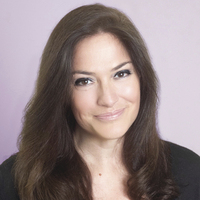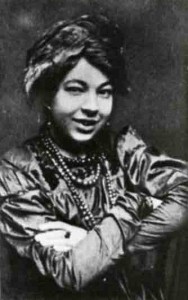The Mystery of Pamela Coleman Smith’s Stage Cards
Readers, please enjoy this guest blog post by Sasha Graham, author of Tarot Diva.
 My book Tarot Diva teaches readers to ignite their intuition, glamorize their lives, and unleash their fabulosity by engaging in an active and exciting tarot practice. Using tarot as a mirror for yourself, you delicately cultivate the ability to listen to your inner voice. The fun of Tarot Diva resides in tasty recipes, empowering exercises, tarot spells, meditations, and musings all based on springing the cards to life. Tarot Diva teaches you literally embody each and every tarot card.
My book Tarot Diva teaches readers to ignite their intuition, glamorize their lives, and unleash their fabulosity by engaging in an active and exciting tarot practice. Using tarot as a mirror for yourself, you delicately cultivate the ability to listen to your inner voice. The fun of Tarot Diva resides in tasty recipes, empowering exercises, tarot spells, meditations, and musings all based on springing the cards to life. Tarot Diva teaches you literally embody each and every tarot card.
Pamela Coleman Smith, the painter of the Rider Waite deck, left behind her quite a legacy of tarot images, images that will no doubt continue to be dissected long after we are all dead and gone. One of the enduring mysteries she left for us is that of tarot’s stage cards.
There are thirteen stage cards within the Rider Waite deck. You can find them by noting which of the cards are drawn as if their characters stand upon a stage. A horizontal line crosses the lower portion of the card. This line denotes a scrim or painted backdrop that appears like the backdrop of a stage.
Go ahead and find them for yourself. Then check with the list below to make sure you have found them all.
 Pamela herself was no stranger to theater; she worked as a set designer in London. It is no surprise that the stage cards exist. The question is why they are they included? We must assume Pamela painted them intentionally. What do they have to tell us? How do we treat these cards differently than the rest of the cards in the deck? What questions do they raise? When placed in the correct order do they tell us a story? Point to other cards? Why aren’t any of the Major cards included and why is the Page of Cups the only stage court card? Why are there thirteen stage cards, and should we connect them with Death, the thirteenth Arcana?
Pamela herself was no stranger to theater; she worked as a set designer in London. It is no surprise that the stage cards exist. The question is why they are they included? We must assume Pamela painted them intentionally. What do they have to tell us? How do we treat these cards differently than the rest of the cards in the deck? What questions do they raise? When placed in the correct order do they tell us a story? Point to other cards? Why aren’t any of the Major cards included and why is the Page of Cups the only stage court card? Why are there thirteen stage cards, and should we connect them with Death, the thirteenth Arcana?
These are questions I begin to address in the stage card chapter of Tarot Diva. They are the questions I’ll keep on asking until we figure out how to arrange these cards in a way that offers us some intelligent explanation, opens a portal into another world of understanding, or both. In the meantime, I’m happy to hear any insights or conclusions you may have regarding these mysterious stage cards:
Two of Pentacles
Four of Pentacles
Six of Pentacles
Eight of Pentacles
Two of Cups
Five of Cups
Ten on Cups
Page of Cups
Two of Swords
Five of Swords
Seven of Swords
Four of Wands
Ten of Wands
Our thanks to Sasha Graham for her guest post! For more from Sasha, read her article, “A Tarot Diva’s Guide to the Ultimate Girl’s Sleepover.”










The 10 of cups is one of the “stageiest” of the
“stage cards” and I’ve always wondered if that was an unconscious/semi-conscius comment on the myth of “happily ever after.”
However, there is also the sheer speed at which Pixie had to complete this project – she may have simply started “recycling” where she could to move the deck along.
The Five of Cups doesn’t look like one of the stage cards… but the Nine of Wands does….
I have always wondered about those stage cards. Why those cards and not all the cards? Is it because they posed for her for those pictures…while on a stage? Those cards have always been a bit of an enigma to me…such a mystery.
Thalassa, would be interesting to find out if The Ten of Cups was in fact the last one she completed. Would have been a nice ending. The Ten of Pentacles, although not a stage card, always reminds me of the end of a Shakespeare show where everyone piles onstage at the finale.
Vera, I included the Five of Cups as a stage card due to the black line crossing the background – the bottom of the scrim. I noticed as well, that that curved bridge only occurs on two cards, both stage cards, The Five of Cups and The Four of Wands.
Donnaleigh, I have looked at them, rearranged them and tried to figure it out ~ to no avail. The best I can figure is to use them as a jumping off points for additional questions to ask yourself/client when they appear.
I’m wondering if there is something in the stage cards that suggests considering how things look to others vs. how they feel to oneself, or even how things are at the heart level vs. the ego level. Some of the cards lend themselves more readily than others to this perspective, tho.
Forgot to introduce myself! I just started studying with Rachel Pollack, and I got your book, Tarot Diva, as well as Rachel’s 78 Degrees of Wisdom. Loving both!
Sasha,
Though I am very interested in and facinated by Pamela (Pixie) Coleman Smith, I wonder why there is no apparent interest in or detailed knowledge of Jessie Burns Parke, who illustrated the Paul Foster Case Tarot Deck. I have exhausted Ancestry.com, of which I am a member, and other leads to no avail. She is only briefly mentioned on the B.O.T.A. website and later editions of the Keys have dropped Jessie’s monogram altogether, which formerly appeared on Tarot Key 9, The Hermit!
I know Jessie was born in Paterson New Jersey on December 2nd 1889, lived with her parents in Arlington Heights, Mass. for some time and died somewhere in 1964. That’s it! Nothing else seems to be available about her life, other than where she studied and exhibited. Those sources provide no information.
Perhaps you have some information regarding her that would provide Tarot lovers and researchers knowledge of her contributions and provide, as well, Jessie with some deserved recognition.
Thank you for any help you may give.
Chuck McLaughlin
I have been working to figure out the meaning behind the stage cards for a while, without finding any real answers. Sadly, I really didn’t find any here either. Does the author of this article not consider the Nine of wands or the Eight of cups stage cards? If not, why?
I think the nine of wands is obviously a stage card and missing from your list. The eight of pentacles could be, but it has the least of the double horizon line of any of the stage cards.
The eight of cups also has the stage structure, but like the ten of cups and five of cups on your list above, it lacks a double horizon line behind those cups. It also breaks the protocol by having the figure “painted” on the backdrop rather than an “actual actor” in front of it.
Is it significant to you that the number of stages cards is 13? If I were trying to keep that, I might drop the eight of pentacles and add the nine of wands.
I like in your book how you advise deploying theatrical metaphors for these cards—who is the actor, audience, director, playwright, etc.